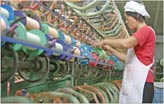Society
Ambitious plan overcame debate and difficulties
Updated: 2011-06-14 08:20
By Tan Zongyang (China Daily)
BEIJING - The world's longest high-speed rail line finally overcomes timeframe and technology disputes to arrive a year ahead of schedule.
Why is the high-speed line needed?
China constructed its first railway link between Beijing and Shanghai in 1968 with the completion of the Nanjing Yangtze River Bridge.
In the early 1990s, a proposal was put forward by railway officials to build a new faster track to transport the ever-increasing number of passengers and leave more room for cargo transportation on the existing line.
This proposal was the germ of the idea for the Beijing-Shanghai high-speed railway.
When should the tracks be built?
After soliciting suggestions from experts, China's railway authority filed an assumption report at the end of 1990 to map out a new fast track between Beijing and Shanghai. The plan, ambitious at the time, stirred public controversy over its huge cost and technical complexity.
There was also a debate about when the line should be constructed. The debate lasted for several years until the government eventually made the decision in 1997 that a new line should be built and "the earlier the better".
However, a new debate then arose over what technology the new line would use.
Which technology is the best choice?
Engineers disagreed over which track technology would be used for the new line.
Supporters of maglev technology believed China had already mastered the core technology and it was the right time to use it to propel China's railway system forward.
However, the majority of experts voted for a high-speed railway based on traditional wheel track, on the grounds it would be able to link with China's existing railway network.
A high-speed rail line was eventually chosen as experts from the Ministry of Railways agreed that trains without wheels were "unrealistic" over a long distance.
At the beginning of 2006, the State Council approved the plan for a high-speed railway between the two metropolises, and construction began two years later.
Although it took 18 years for the fast track to develop from a simple idea to reality, its completion came one year earlier than expected and the high-speed rail link between the two cities will open for service later this month.
E-paper

Pearl on the Yangtze
Wuxi is considered a town of natural beauty and its motto is "city of water and warmth".
Prose and consternation
Riding on a mystery train
Way of a warrior
Specials

Wealth of difference
Rich coastal areas offer contrasting ways of dealing with country's development

Seal of approval
The dying tradition of seal engraving has now become a UNIVERSITY major

Making perfect horse sense
Riding horses to work may be the clean, green answer to frustrated car owners in traffic-trapped cities




